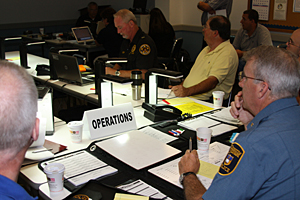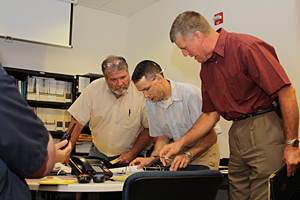
- Rozovsky wins prestigious NSF Early Career Award
- UD students meet alumni, experience 'closing bell' at NYSE
- Newark Police seek assistance in identifying suspects in robbery
- Rivlin says bipartisan budget action, stronger budget rules key to reversing debt
- Stink bugs shouldn't pose problem until late summer
- Gao to honor Placido Domingo in Washington performance
- Adopt-A-Highway project keeps Lewes road clean
- WVUD's Radiothon fundraiser runs April 1-10
- W.D. Snodgrass Symposium to honor Pulitzer winner
- New guide helps cancer patients manage symptoms
- UD in the News, March 25, 2011
- For the Record, March 25, 2011
- Public opinion expert discusses world views of U.S. in Global Agenda series
- Congressional delegation, dean laud Center for Community Research and Service program
- Center for Political Communication sets symposium on politics, entertainment
- Students work to raise funds, awareness of domestic violence
- Equestrian team wins regional championship in Western riding
- Markell, Harker stress importance of agriculture to Delaware's economy
- Carol A. Ammon MBA Case Competition winners announced
- Prof presents blood-clotting studies at Gordon Research Conference
- Sexual Assault Awareness Month events, programs announced
- Stay connected with Sea Grant, CEOE e-newsletter
- A message to UD regarding the tragedy in Japan
- More News >>
- March 31-May 14: REP stages Neil Simon's 'The Good Doctor'
- April 2: Newark plans annual 'wine and dine'
- April 5: Expert perspective on U.S. health care
- April 5: Comedian Ace Guillen to visit Scrounge
- April 6, May 4: School of Nursing sponsors research lecture series
- April 6-May 4: Confucius Institute presents Chinese Film Series on Wednesdays
- April 6: IPCC's Pachauri to discuss sustainable development in DENIN Dialogue Series
- April 7: 'WVUDstock' radiothon concert announced
- April 8: English Language Institute presents 'Arts in Translation'
- April 9: Green and Healthy Living Expo planned at The Bob
- April 9: Center for Political Communication to host Onion editor
- April 10: Alumni Easter Egg-stravaganza planned
- April 11: CDS session to focus on visual assistive technologies
- April 12: T.J. Stiles to speak at UDLA annual dinner
- April 15, 16: Annual UD push lawnmower tune-up scheduled
- April 15, 16: Master Players series presents iMusic 4, China Magpie
- April 15, 16: Delaware Symphony, UD chorus to perform Mahler work
- April 18: Former NFL Coach Bill Cowher featured in UD Speaks
- April 21-24: Sesame Street Live brings Elmo and friends to The Bob
- April 30: Save the date for Ag Day 2011 at UD
- April 30: Symposium to consider 'Frontiers at the Chemistry-Biology Interface'
- April 30-May 1: Relay for Life set at Delaware Field House
- May 4: Delaware Membrane Protein Symposium announced
- May 5: Northwestern University's Leon Keer to deliver Kerr lecture
- May 7: Women's volleyball team to host second annual Spring Fling
- Through May 3: SPPA announces speakers for 10th annual lecture series
- Through May 4: Global Agenda sees U.S. through others' eyes; World Bank president to speak
- Through May 4: 'Research on Race, Ethnicity, Culture' topic of series
- Through May 9: Black American Studies announces lecture series
- Through May 11: 'Challenges in Jewish Culture' lecture series announced
- Through May 11: Area Studies research featured in speaker series
- Through June 5: 'Andy Warhol: Behind the Camera' on view in Old College Gallery
- Through July 15: 'Bodyscapes' on view at Mechanical Hall Gallery
- More What's Happening >>
- UD calendar >>
- Middle States evaluation team on campus April 5
- Phipps named HR Liaison of the Quarter
- Senior wins iPad for participating in assessment study
- April 19: Procurement Services schedules information sessions
- UD Bookstore announces spring break hours
- HealthyU Wellness Program encourages employees to 'Step into Spring'
- April 8-29: Faculty roundtable series considers student engagement
- GRE is changing; learn more at April 15 info session
- April 30: UD Evening with Blue Rocks set for employees
- Morris Library to be open 24/7 during final exams
- More Campus FYI >>
2:39 p.m., July 31, 2009----What would happen if a train derailed in Newark? What if the train was carrying toxic chemicals? And everyone within a mile radius needed to evacuate?
University of Delaware first responders now have a good sense of what they'd do in just such an emergency. Twenty University employees joined City of Newark employees on July 24 in an emergency management exercise designed to test their skills and prepare them for an actual emergency.
“A train derailment involving a hazardous material is certainly an emergency event that could occur in Newark since numerous trains travel through the city every day,” said Albert J. “Skip” Homiak Jr., executive director of campus and public safety. “Such a situation would have a significant impact on the University since it would most likely result in an evacuation of the entire area. We continually conduct training exercises for an active shooter, flu pandemic and severe weather scenarios, however it is equally important to be prepared for a train derailment since there could be catastrophic results if one occurred.”
The drill, organized by CSX railway, was intended to feel as real as possible. The moderators, Compliance Associates Inc., released information to participants in short briefs, each one building upon the last, beginning with an alert that a train had derailed on the tracks parallel to Elkton Road, between Amstel Avenue and Apple Road. The train would have been off the tracks near Rodney and Dickinson residence hall complexes.
“The exercise was very realistic,” said Marcia Nickle, UD emergency preparedness coordinator. Nickle said built-in hurdles helped simulate the complications that would exist in reality. For instance, the command group, those who would be at the scene making executive decisions, was kept in a separate room from the people who would be scattered elsewhere on campus.
“Having the command group in another room made the flow of communication seem very much like it would with a true incident. The use of two-way radios gave the feel of a rush of information,” she said.
University departments involved in the exercise included: Residence Life, Office of Communications & Marketing, Department of Environmental Health and Safety, Public Safety, Facilities Management, and the Disaster Research Center.
Off-campus entities represented were Newark Police Department, City of Newark, CSX, Aetna Hose, Hook and Ladder Co. and REACT Environmental Services, Inc.
Article by Andrea Boyle



